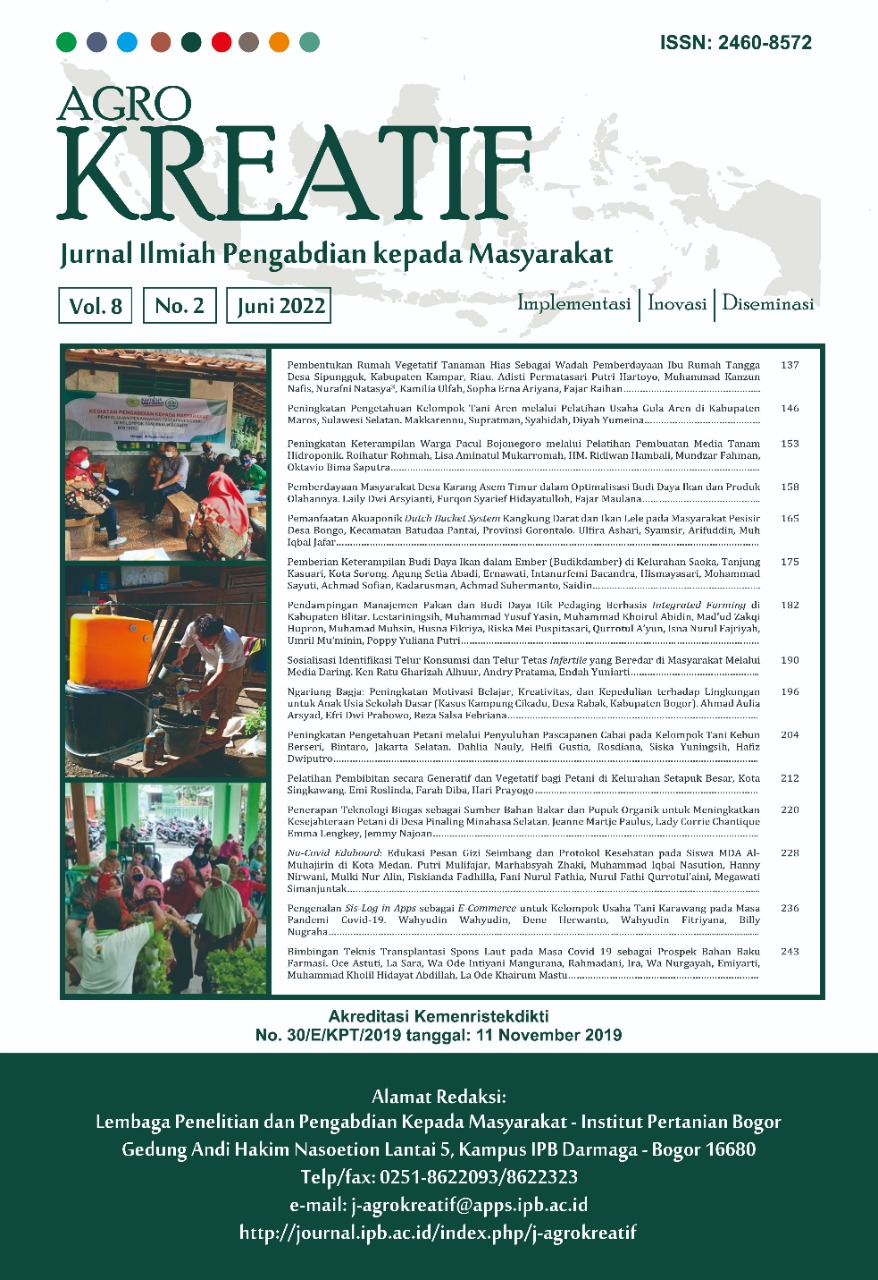Bimbingan Teknis Transplantasi Spons Laut pada Masa Covid 19 sebagai Prospek Bahan Baku Farmasi
Abstract
Sponges are organisms associated with coral reefs and have potential as pharmaceutical raw materials. One of the problems is that most people are not aware of the importance of this ecosystem and still use fishing gear that is not environmentally friendly, this causes the coral reef ecosystem to also suffer damage. This community service aims to educate and provide technical guidance to the younger generation of Lalowaru Village about the benefits of sponges and how to transplant sea sponges. The youth group was chosen as the target because during this Covid-19 period the youth organization in Lalowaru Village, South Konawe Regency did not go to schools as usual, so this education can provide knowledge that can be applied in protecting the aquatic environment. The implementation method consists of two stages, namely the first stage of field observations including licensing with village officials and preliminary study interviews and the second stage of socialization and transplantation practices. The activity was carried out for two days with 10 participants. Measurement results were concluded through interviews from before carrying out activities and after service activities. The results of the training and mentoring activities show that all target audiences understand the benefits of sponges as pharmaceutical raw materials that can be developed, as well as transplantation techniques. This increase in the knowledge of the young generation of youth organizations occurred after technical guidance through this service.
Downloads
References
Bell JJ. (2008). The functional roles of marine sponges. Estuarine, coastal and shelf science 79(3): 341‒353. https://doi.org/10.1016/j.ecss.2008.05.002
Fatmawati. 2015. Hubungan biofilm streptococcus mutans terhadap resiko terjadinya karies gigi. Jurnal kedokteran gigi Stomatognatic. 8(3): 127–130.
Haris. 2019. Keanekaragaman dan komposisi jenis spons (Porifera: Demospongiae) di Reef Flat Pulau BarrangLompo island. Journal of Fisheries and Marine Science. 3(1): 26‒36. https://doi.org/10.35911/torani.v3i1.11362
Henkel TP, Pawlik JR. 2011. Host specialization of an obligate sponge-dwelling brittlestar. Aquatic Biology. 12(1): 37‒46. https://doi.org/10.3354/ab00322
Hooper JNA. 2000. Guide to Sponge Collection and Idenification, Version August. Page: 33‒38
Ireland CM, Molinski TF, Roll DM, Zabriskie TM, McKee TC, Swersey JC, Foster MP. 1989. Natural Product Peptides from Marine Organisms. Bioorganic Marine Chemistry. 3: 1‒27. https://doi.org/10.1007/978-3-642-74560-7_1
Mangurana WOI, Yusnaini, Sahidin. 2019. Analisis LC-MS/MS (Liquid Crhomatogaph Mass Spectrometry) dan Metabolit Sekunder serta Potensi Antibakteri Ekstrak n-Heksana Spons Callyspongia aerizusa yang diambil pada kondisi tutupan terumbu Karang yang berbeda di Perairan Teluk Staring. Jurnal biologi tropis. 19(2): 131‒141. https://doi.org/10.29303/jbt.v19i2.1126
Marliave JB, Conway KW, Gibbs DM, Lamb A, Gibbs C. 2009. Biodiversity and rockfish recruitment in sponge gardens and bioherms of southern British Columbia, Canada. Marine Biology. 156(11): 2247‒2254. https://doi.org/10.1007/s00227-009-1252-8
Muliani, Suryati E, Tompo A, Parenrengi A, Rosmiati. 1998. Isolasi Bioaktif Bunga Karang Sebagai Fungisida pad Benih Udang Windu Penaeus monodon. Jurnal Penelitian Perikanan Indonesia. 4(2): 13‒23. https://doi.org/10.15578/jppi.4.2.1998.13-23
Munro MHG, Luibrand RT, Blunt JW. 1989. The Search for Antivaral and Anticancer Compounds from Marine Organisms. Bioorganic Marine Chemistry. 1: 94‒176.
Petrus 2002. Pertumbuhan sponge (Auletta sp.) secara transplantasi dengan Panjang benih berbeda. Jurnal penelitian perikanan Indonesia. 8: 49‒54. https://doi.org/10.15578/jppi.8.5.2002.49-54
Proksch P. 1999. Pharmacologically Active Natural Products from Marine Invertebrates and Associated Microorganisms. In: Prosidings Seminar Bioteknologi Kelautan Indonesia I’98. Jakarta (ID): Lembaga Ilmu Penelitian Indonesia (LIPI). Page: 33–40.
Rasyid A. 2009. Senyawa-senyawa Bioaktif dari Spons. Oseana Hal 2532.
Romimohtarto K, Juwana S. 2001. Biologi Laut: Ilmu Pengetahuan Tentang Biota Laut. Jakarta (ID): Pusat Penelitian dan Pengembangan Oseanologi, LIPI.
Rudi E, Ismudi M. 2010. Ikan Karang Perairan Aceh dan Sekitarnya. Lubuk Agung (ID): Bandung.
Sabdono A. 2011. Microbial symbionts in marine sponges: Marine natural product factory. Journal of Coastal Development. 11(2): 57‒61.
Sale PF. 2002. Coral Reef Fishes (Dynamics and Diversity in a complex Ecosystem). Canada (US): University of Winsdor.
Schmidt EW. 2008. Trading molecules and tracking targets in symbiotic interactions. Nature chemical biology. 4(8): 466‒473. https://doi.org/10.1038/nchembio.101
Sudjana N. 2004. Dasar-dasar Proses Belajar Mengajar. Bandung (ID): Sinar Baru Algensido Offset.
Sugiyono. 2017. Metode Penelitian Kuantitatif, Kualitatif, dan R&D. Bandung: Alfabeta, CV
Supriharyono.2000. Konservasi Ekosistem Sumberdaya Hayati di Wilayah Pesisir dan Laut Tropis. Pustaka Pelajar (ID): Yogyakarta.
Suryati E, Parenrengi A, Rosmiati, Laining A. 1999. Penapisan dan Analisis Sponge Efektif Sebagai Antibiofouling di Tambak dan Keramba Jaring Apung. Balai Penelitian Perikanan Pantai Maros Sulawesi Selatan. Jurnal Marina Chimica Acta. 16‒20.
Parenrengi A, E. suryati, Dalfiah dan Rosmiati (1999). Studi Toksisitas Ekstrak Sponge Auletta sp. Callyspongia sp., dan C, Pseudoreticulata Terhadap Nener Bandeng (Chanos chanos). Jurnal Penelitian Perikanan Indonesia 4: 15‒22.
Thamrin. 2006. “Karang” Biologi Reproduksi dan Ekologi. Minamandiri Pres (ID): Pekanbaru.
Kobayashi M, Rachmaniar R. 1999. Overview of Marine Natural Product Chemistry. Dalam: Prosidings Seminar Bioteknologi Kelautan. Jakarta (ID): LIPI. Hal: 23–32
This work is licensed under a Creative Commons Attribution-NonCommercial 4.0 International License.



















